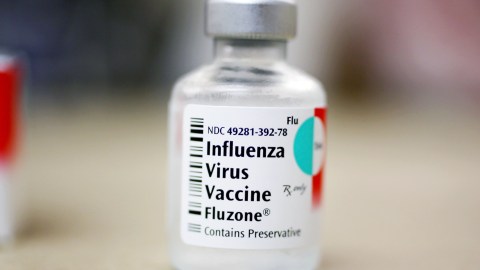Anti-Vaccine Parents Are Less Dangerous Than Low Flu Vaccination Rates

You’ve heard about the big vaccines problem, right, that some parents aren’t vaccinating their kids? Hundreds of millions of dollars have been spent trying to solve this threat to public health. But resistance to childhood vaccination isn’t close to the most worrisome category of vaccination reluctance in the United States. Yes, it’s tragic that hundreds of children are getting sick from measles or dying of pertussis (whooping cough) in communities where vaccine refusal has allowed what should have been isolated cases to spread. Yes, it’s infuriating that some parents are, by protecting their kids, putting other kids at risk. But this problem is nowhere near the health threat Americans face because of the astoundingly low number of people getting vaccinated each year against the flu.
The Centers for Disease Control and Prevention (CDC) estimates that since the 1970s influenza has killed between 3,000 and 49,000 people each year (the severity of each flu season varies), most of whom were 65 or older. An average of 200,000 a year get so sick they have to be hospitalized, 20,000 of whom are kids under 5. Influenza sickens and kills far more children than do measles and pertussis outbreaks caused by childhood vaccination hesitancy.
Between 5 percent and 20 percent of the entire U.S. population gets the flu every year. The health and economic costs of this are staggering. A 2007 analysis in the journal Vaccine reported;
Based on the 2003 U.S. population, we estimated that annual influenza epidemics resulted in an average of 610,660 life-years lost, 3.1 million hospitalized days, and 31.4 million outpatient visits. Direct medical costs averaged $10.4 billion annually. Projected lost earnings due to illness and loss of life amounted to $16.3 billion. The total economic burden of annual influenza epidemics using projected statistical life values amounted to $87.1 billion.
(Population growth since 2003 suggests these numbers are roughly 10-15 percent higher now.)
The Centers for Disease Control recommends an annual flu vaccination for anyone over 6 months old (annual, because flu vaccines target only one strain and new strains arise all the time). Herd immunity for flu vaccine — where enough people are vaccinated so if one person gets sick the disease can’t spread — would be achieved if roughly 80 percent of us, four people out of five, are inoculated … 90 percent for those 65 and older, the age group most at risk. There isn’t a single age group that meets any of those targets.
U.S. Influenza Vaccination Rates — 2014-15 Estimates
- Children 6 months to 17 – 59 percent
- Adults 18-49 years – 34 percent
- Adults 50-64 years – 47 percent
- 65 and older – 67 percent
Why are these numbers so low? Nearly half the respondents in one study said either, “I don’t need it,” or “I didn’t get around to it.” This translates to, “It’s only the flu. I’m not worried.” That’s the same selfishness those parents who don’t vaccinate their kids are accused of. People with flu spread can spread the disease to others. If you get the flu, you might only get sick — REALLY sick — but that grandparent or baby who visited could get it and die. Fourteen percent said, “I don’t believe in flu vaccines.” (Flu vaccines aren’t 100 percent effective, but even the lowest efficacy rates significantly reduce your chances of getting really seriously ill.) And 14 percent said “I might get the flu from the vaccine.” (Like the association between childhood vaccines and autism, this common myth is incorrect.)
In addition, other surveys also suggest that general public worries about vaccine safety may also be contributing to low flu vaccination rates.
The public health authorities working so hard on the childhood vaccine problem have to do much more to increase flu vaccination rates, such as;
Such programs would undoubtedly be cost effective. They certainly would protect public health — including childhood health — far more than efforts to increase childhood vaccination rates (work that should continue). A CDC report in December 2014 found that;
If influenza vaccination levels had reached the Healthy People 2020 target of 70 percent (for the 2013-14 flu season), an estimated additional 5.9 million illnesses, 2.3 million medically attended illnesses, and 42,000 hospitalizations associated with influenza might have been averted.
It’s understandable that the childhood vaccination issue is getting more attention. We worry more about risks to kids than risks to adults. We worry less about risks that are familiar — like the flu — and less about risks if we feel like we have some control, as in “I can protect myself if I want to. I can always go get a flu shot.” We also worry more about risks that are in the news, like the childhood vaccination issue, than those we don’t hear about. And unless there is a huge epidemic of influenza, or a new variety of flu going around, or a shortage of flu vaccine, this huge health threat doesn’t make news.
So far, this flu season (which runs from December to May) has been a quiet one; only roughly 2,000 pneumonia and influenza-related deaths, 11 of which were kids. It will be great — and not so great — if things stay that way. Great because fewer of us will get sick or die. Not so great, because without greater public awareness, we’ll slide though yet another flu season without sufficient public concern to press our public health officials to do as much to increase influenza vaccination rates as they’ve been doing on childhood vaccination for years. Which leaves us all at much greater risk.





